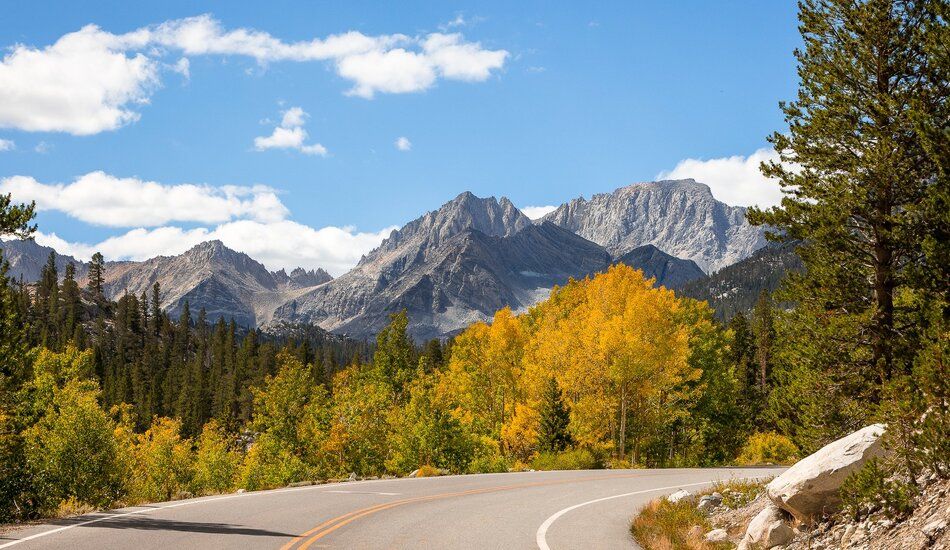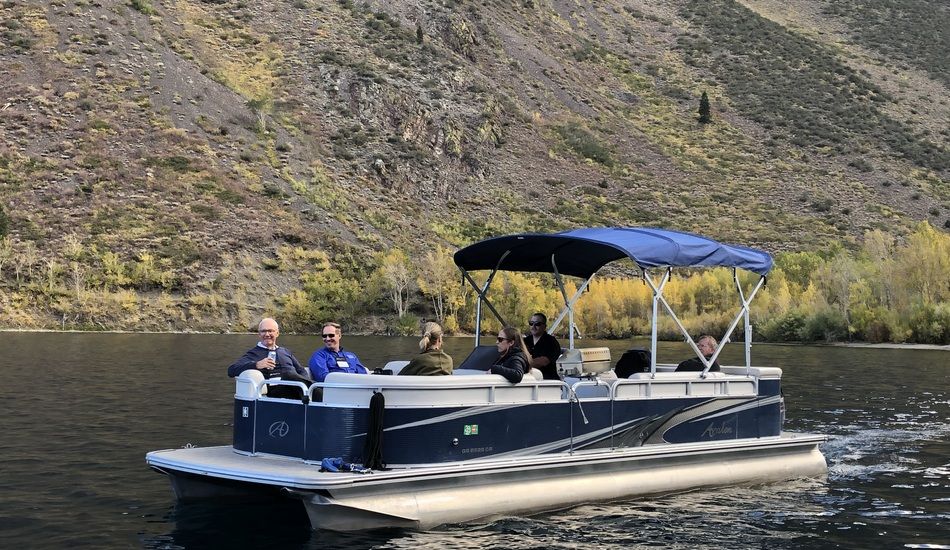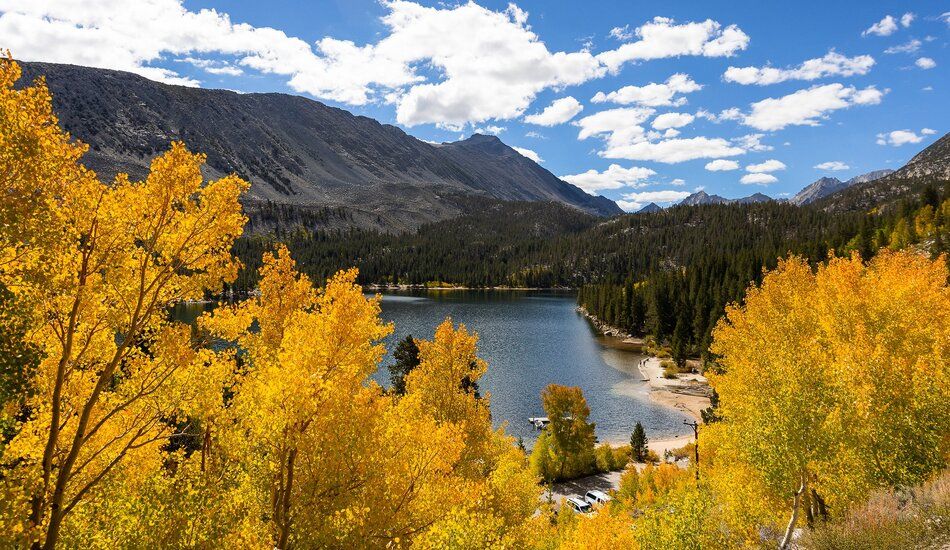Offering the cozy ambience of a first-class alpine ski resort, this isolated mountain playground in eastern California takes on a special glow in autumn
Even many Californians think they have to go out East to witness the splendor of fall foliage, but the Sierra Nevada Mountains offer their own blazes of glory, as I witnessed on my October trip to the high-altitude resort town of Mammoth Lakes.
While Mammoth Lakes is best known as a winter sports mecca, fall finery is a less-hyped treasure I’ve been telling everyone about. The masterful blend of autumn hues and mountain majesty exceeded my expectations.
Groves of quaking aspens, whose electric yellows and flaming oranges paint the slopes, provide a brilliant contrast to the firs and pines. Set against picture-postcard mountain scenery under clear blue skies, it’s something few parts of the country can duplicate. Whether I was hoofing it on the trails, boating on Convict Lake or soaking in color-splashed vistas from the road, the golden spectacle had me taking pictures like crazy.
The East, I discovered, doesn’t have a monopoly on Mother Nature’s annual show.
Mammoth Lakes is the Complete All-Season Resort in California
The Mono County community of Mammoth Lakes, at 8,051 feet above sea level and home to about 8,500 permanent residents, is a kingdom unto itself, the nearest major airport being three hours away in Reno, Nevada. The relative remoteness just adds to its appeal.
An all-season vacation haven, Mammoth Lakes has amenities aplenty, offering more than 65 restaurants and a variety of hotels and vacation rentals, not to mention a full-service hospital and a small commercial airport with flights from Southern California during ski season.
Boasting a summit elevation of 11,053 feet, Mammoth Mountain Ski Area is the highest resort in California. Served by 28 chairlifts and two gondolas, it counts 150 distinct runs. While Mammoth may not be on skiers’ national radar, “Southern California considers us their backyard ski hill,” says Lara Kaylor of Mammoth Lakes Tourism. The drive from Los Angeles (and San Francisco and Las Vegas) is 5.5 hours.
Though it takes some traveling to get there, Mammoth Lakes makes a great base of operations for exploring the Eastern Sierra and Yosemite National Park, whose eastern entrance is 45 minutes from town. Fall foliage time in this neck of the woods means fewer crowds than the busy winter and summer seasons.
Surrounded on all sides by protected federal lands, the town can’t expand—it can only build up. Its centerpiece is the Village at Mammoth, a collection of restaurants and shops surrounding a landscaped plaza, a welcoming space that invites strolling and warming up at the communal fire pits. The clocktower building gives this “downtown” a cozy touch of Alpine Europe.

The Village at Mammoth, a cluster of shops, eateries and gathering spaces, serves as the “downtown” for the all-season resort town of Mammoth Lakes, California. (Randy Mink Photo)
I stayed at the Westin Mammoth, right across from the Village, where a kitchen and fireplace in each of the individually owned condos make guests feel right at home. Under construction next door is the Limelight Hotel Mammoth & Residences, which will open in 2024.
The Sierra Nevada Resort, occupying a 1967 building originally owned by real estate developer and Los Angeles Lakers owner Jerry Buss, opened in November 2022. A Western classic reimagined, the resort was a preferred getaway for Hollywood greats like John Wayne, Dean Martin and Frank Sinatra. A gallery wall pays homage to the era with black-and-white photographs of celebrity guests.
Though shops in town purvey merchandise bearing images of prehistoric woolly mammoths, the area harbors no remains of the extinct elephant species. Rather, “Mammoth” comes from the man who started the Mammoth Mining Company, a name he thought would attract fortune seekers. The company lasted only two years.
“Lakes” in the town’s name is derived from the five renowned fishing lakes in Mammoth Lakes Basin, an idyllic setting only five minutes from the Village via the free Lakes Basin Trolley. (There is no lake named Mammoth.) Almost 100 lakes lie within a 20-mile radius. My group visited several of them on our fall hikes, getting some great pictures of the pretty foliage and rocky crags reflecting on the pristine water.
Things to Do in Mammoth Lakes During the Fall
On our early October trip, temperatures reached into the 70s, dipping to the low 30s at night. The fall-color season spans a two-month period, but the best time for leaf-peeping generally is mid-September to mid-October.
Trees in the Mountain West display little of the fiery reds seen in New England every fall, but the aspens’ yellow and orange leaves, mixing with the lime-colored ones that have not yet turned, create a spectacle nonetheless. Cottonwoods, willows and bigleaf maples add pop of their own. An autumn snowfall will inject a novel element, providing a white background for the turning leaves.

The Sierra Nevada’s granite peaks provide a dramatic backdrop for forests accented with the golden leaves of quaking aspen trees. (Photo credit: Patrick Griley/Mammoth Lakes Tourism)
Just the majestic Sierra Nevada setting—the stuff of calendars and travel posters—mirrors a grandeur not found in the East. Marveling at the changing leaves, you have to remember to pause and take in the big picture, an awe-inspiring tableau of verdant meadows, rugged high desert and jagged mountain crests.
Forming a spine that stretches 400 miles along the eastern side of California, the Sierra Nevada abounds with mighty granite peaks, many of them rising to heights of 10,000 to 14,000 feet. Indeed, this is a special corner of the world, a stunningly beautiful place that locals sometimes have to remind themselves to not take for granted.
The jaw-dropping panoramas lure movie production companies to the Mammoth Lakes area. One day, just beyond the town limits, our van was flagged down by a police officer, who was stationed there to alert motorists that a film crew on the roadside ahead was shooting a commercial. The area is a natural for car commercials.
On separate days, we hit two hiking trails on either side of Coldwater Canyon, a short drive from the Village. Each hike had a lake—Emerald Lake or Heart Lake—as its destination. At one point on each trail we passed a sign indicating we were entering the John Muir Wilderness of Inyo National Forest.
The leisurely guided hikes let us stop often to drink from our water bottles—you get thirsty at these altitudes—and admire the scenic exclamation points spread out before us. Just as impressive as the dazzling aspen leaves were the lofty, oh-so-vertical Jeffrey pines, the area’s dominant pine species.
Scenic Routes Showcase Fall Beauty in Mono County, California
Farther afield, we took US Highway 395 north from Mammoth to two fall foliage hotspots—Lundy Canyon and June Lake Loop—popular with hikers and motorists. Lundy Canyon Road ends at a trail considered one of the best for fall color hikes in the West. A view of Lundy Falls flanked by colorful aspens appears within the first mile, and the canyon offers a beaver dam as a bonus. A drive along the 16-mile June Lake Loop features waterfalls, four lakes and an intimate village.
Our travels on US 395, a designated California Scenic Byway, also included a brief stop at another Mono County must-see—mineral-rich Mono Lake, near the village of Lee Vining. More than twice as salty as the ocean, the ancient inland sea intrigues visitors with its eerie tufa towers, oddly shaped limestone structures created by freshwater springs that bubble up through the lake’s alkaline waters.
A paradise for photographers and bird-watchers, Mono Lake attracts migrating birds that feed on the alkali flies and tiny brine shrimp. Kayakers can paddle among the tufas, and there are interpretive trails that provide close-up looks at the otherworldly formations.
Cruising the 395 corridor, often praised as one of America’s best road trips, we stopped for photos at one of the pull-outs for Conway Summit, famed for the swaths of autumn color that paint its hillsides.

Bodie State Historic Site preserves the most authentic ghost town from California’s Gold Rush era. (Randy Mink Photo)
Experience a Real Gold Rush Era Ghost Town
North of Conway Summit, near the town of Bridgeport, lies Bodie State Historic Park, the site of the largest unrestored and best-preserved ghost town from California’s Gold Rush era. This outdoor museum, a trip highlight for me, interprets what is left of Bodie, a wild ’n’ woolly mining camp that once contained 30 gold and silver mines, nine stamp mills and more than 60 saloons, not to mention a red-light district and a large Chinatown with opium dens. In its 1877-1881 heyday, the boomtown had a population of 8,000; the last residents left in the 1960s, when the land was turned over to California State Parks.
On wide dirt paths, tourists pass weathered houses and commercial buildings scattered across the high desert landscape of rabbit brush and sagebrush. They take time to visit the 1882 Methodist church, poke around the cemetery, inspect rusted vehicles and machinery, and peer through the windows of the hotel, jail, saloon and schoolhouse (used until 1942, the year mining was discontinued). The general store is stocked with dust-covered merchandise dating back to 1912.
The 170-some buildings are described as being in “a state of arrested decay.” That means the roofs, windows and foundations are repaired and stabilized, not restored.
Visit Yosemite National Park, Too
Planning my trip to Mammoth Lakes, I was most looking forward to the day in Yosemite National Park, one of America’s bucket-list national parks. Our group took a full-day tour with MAWS (Mammoth All Weather Shuttle), a local transportation company that deploys 7- and 14-passenger vehicles to Yosemite. While hordes of people pack the park in summer, fall is less crowded.
To reach Yosemite’s less used eastern gate (elevation 9,945 feet), we traveled from Mammoth Lakes to Tioga Pass, the highest paved mountain pass in California. Entering from the east side is much more dramatic than from the three western entrances. The drive afforded grand High Sierra vistas as we made our way down into the valley, where the park’s top landmarks reside. The Tunnel View overlook was thronged with visitors framing the ultimate shots of iconic granite monoliths El Capitan and Half Dome. We also got a glimpse of Bridalveil Fall, which had some water at the top, but spring and early summer are best for seeing the park’s waterfalls in all their thundering fury.

The Tunnel View overlook affords photographers the perfect opportunity to frame a shot of El Capitan, the iconic granite monolith rising almost 3,000 above the valley floor at Yosemite National Park. (Randy Mink Photo)
Another Yosemite highlight was our one-mile hike to Tuolumne Grove of Giant Sequoias, one of the park’s three such groves featuring enormous trees that live to be more than 2,000 years old. Related to redwoods, giant sequoias grow to 300 feet and measure nearly 30 feet around. We posed by a massive specimen named Big Red, the first sequoia on the paved path. The one-mile hike between the parking lot and the grove seemed more like two miles on the uphill trudge back—bring your water bottle and take breaks.
Our day in Yosemite ended with a visit to El Capitan Meadows, where we watched awestruck as daring rock climbers from around the world scaled the sheer face of El Capitan. Some of the adventurers, we were told, sleep overnight on ledges to break up their trek. The record time to reach the summit is two hours and 45 minutes.
Outstanding Places to Eat in Mammoth Lakes
Hikers, climbers, and skiers can work up mammoth-sized appetites. Fortunately, the town of Mammoth Lakes has something for every taste, from the simple to the sophisticated. Here are just a few of the dining spots that put a smile on my face:
- Side Door Wine Bar & Cafe, at the Village of Mammoth, specializes in crepes, paninis, fondue, tapas, and cheese and charcuterie plates. I’ll never forget the pillowy, plate-size chicken pesto crepe with creamy goat cheese, which was followed by luscious Nutella, strawberry and frosted cinnamon roll crepes our group shared for dessert.
- Rivaling those crepes was the best-ever bacon cheeseburger I devoured at Burgers Restaurant, across the road from the Village. Just as memorable: Burgers’ seasoned fries with a decadently rich blue cheese dip.
- Petra’s Bistro & Wine Bar, next door to Burgers, is a beloved temple of dining. Right below it, the Clocktower Cellar pub offers a vast selection of beers and whiskeys, plus Bavarian-inspired menu items like wieners with sauerkraut, schnitzel sandwiches and sausage platters. Both places are part of Alpenhof Lodge, a Mammoth Lakes mainstay managed by the Schaubmayer family since 1972.
- For satisfying meals in a cozy setting, you can’t beat The Warming Hut’s “mountain comfort food.” I started with a bowl of rich tomato bisque thickened with coconut milk and seasoned with herbs, then feasted on chicken ’n’ biscuits. Others in my group raved about the chicken ’n’ waffles and corned beef hash. Reuben, Cuban and the three-cheese Grilled Cheezy sandwiches garnered praise as well.
- Mammoth Rock ’N’ Bowl, at the gourmet end of the spectrum, offers knockout French-inspired fare at its Mammoth Rock Brasserie as well as 12 lanes for bowling. Tables on the balcony terrace pair the dining experience with lovely mountain views.
- Also in the upscale category is The Restaurant at Convict Lake, whose menu features venison, beef Wellington, cashew-crusted rainbow trout and roast Long Island duckling. Besides the duck, I enjoyed escargot en croute, one of my all-time favorite appetizers. Bananas Foster flambéed tableside capped our meal with a festive flourish.

The marina at Convict Lake offers pontoon and kayak rentals. (Randy Mink Photo)
Before dinner, our group had rented a pontoon for a laidback fall-color cruise on Convict Lake. The relatively flat, two-mile walking path around the lake passes through a beautiful aspen grove, providing yet another way to experience Mammoth Lakes’ prettiest season.
For more information on other top destinations in the American West, you can subscribe to Leisure Group Travel for FREE
By Randy Mink, Senior Editor
Lead photo courtesy of Patrick Griley/Mammoth Lakes Tourism






